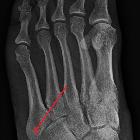Jones-Fraktur

















A Jones fracture is an extra-articular fracture at the base of the fifth metatarsal bone.
Pathology
It is a transverse fracture at the base of the fifth metatarsal, 1.5 to 3 cm distal to the proximal tuberosity at the metadiaphyseal junction, without distal extension.
Mechanism
The fracture is believed to occur as a result of significant adduction force to the forefoot with the ankle in plantar flexion .
Radiographic features
Plain radiograph/CT
Jones fracture is located at the metadiaphyseal junction, approximately 2 cm (1.5-3 cm) from the tip of the 5 metatarsal, and has a predominantly horizontal course. It should not extend distally, nor should it extend to involve the articular surfaces.
Treatment and prognosis
In contrast to avulsion fractures, Jones fractures are prone to non-union (with rates as high as 30-50%) and almost always take longer than two months to heal .
As displacement of the fracture can be increased with persistent weight bearing, immobilization is important as part of the initial therapy, with a non-weight bearing cast for 6-8 weeks.
Internal fixation and even bone grafting may be required in cases of non-union, or where the fracture is significantly displaced.
History and etymology
It was first described by Sir Robert Jones (1857-1933), Welsh orthopedic surgeon, in 1902 .
Differential diagnosis
A number of fractures occur at the base of the 5 metatarsal (see fractures of the proximal fifth metatarsal) as well as entities which mimic fractures. These include:
- stress fracture of the 5 metatarsal
- avulsion fracture of the proximal 5 metatarsal
- os vesalianum or os peroneum
- normal apophysis of the proximal 5 metatarsal
- Iselin disease (apophysitis)
Siehe auch:
- Avulsionsfraktur Basis Metatarsale 5
- Os peroneum
- proximale Frakturen Os metatarsale 5
- Apophysitis an der Basis des Os metatarsale 5 (Iselin-Krankheit)
- Fraktur 5. Mittelfußknochen
- Stressfraktur 5. Mittelfußknochen
und weiter:

 Assoziationen und Differentialdiagnosen zu Jones-Fraktur:
Assoziationen und Differentialdiagnosen zu Jones-Fraktur:



